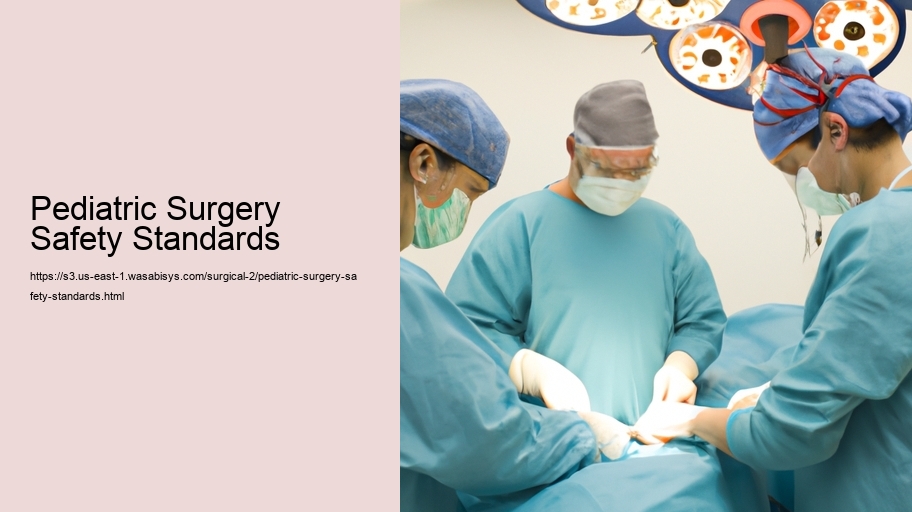Pediatric Surgery Safety Standards
The essence of pediatric surgery lies not only in the intricate procedures that mend the delicate structures of a child's body but also in the encompassing environment of care which ensures the safety and well-being of the young patient. Pediatric surgery safety standards are an amalgamation of protocols, guidelines, and best practices that aim to minimize risks and enhance outcomes for children undergoing surgical intervention.
Pediatric patients present unique challenges due to their smaller anatomy, physiological differences, and varying developmental stages. This demands a specialized approach to their care, tailored to their individual needs. Safety standards in pediatric surgery are designed to address these challenges and are built on several key pillars.
Preoperative Considerations
The journey towards a safe surgical experience for a child begins long before the actual procedure. Preoperative evaluations are critical in understanding the unique health profile of the pediatric patient. This includes a thorough medical history, physical examination, and necessary diagnostic tests. Such evaluations help in identifying any underlying conditions that may affect the course of surgery or anesthesia. Additionally, fasting protocols are adjusted for children to reduce the risk of aspiration while ensuring they are not unduly distressed by long periods without food or drink.
Family-Centered Care
In pediatric surgery, the family plays an integral role in the child's care. Safety standards emphasize the importance of involving family members in the preoperative process. Effective communication helps in setting realistic expectations, reducing anxiety, and obtaining informed consent. This also extends to postoperative care, where families are educated on how to care for their child at home, recognize potential complications, and understand follow-up procedures.
Surgical Team and Environment
The surgical team is a critical component of pediatric surgery safety standards. Surgeons, anesthesiologists, nurses, and ancillary staff involved in the care of pediatric patients should have specialized training and experience. The surgical environment must be equipped with instruments and equipment suited for the size and specific needs of children. This includes appropriately sized anesthesia machines, surgical tools, and implants. Operating rooms should be adaptable to cater to patients ranging from neonates to teenagers.
Anesthesia Safety
Anesthesia in children requires special attention due to their varying responses at different ages. Pediatric anesthesiologists follow strict guidelines to ensure the safe administration of anesthesia. This includes careful monitoring of vital signs, using age and size-appropriate drug dosages, and maintaining body temperature. Pain management is also an essential aspect of anesthesia safety, requiring tailored approaches for effective control while minimizing side effects.
Intraoperative Monitoring
Continuous monitoring during surgery is paramount. Standards dictate that heart rate, blood pressure, oxygen saturation, and other critical parameters be meticulously observed to detect and address any abnormalities promptly. This vigilant surveillance allows for immediate intervention should any complications arise during the procedure.
Postoperative Care and Pain Management
After the surgery, the focus shifts to recovery and pain management. Pediatric patients need to be monitored closely for signs of distress, infection, or other complications. Effective pain management is a cornerstone of postoperative care, with protocols in place to ensure children are as comfortable as possible while minimizing the use of narcotics and their associated risks.
Infection Control
Infection control measures are stringent in pediatric surgical settings. This includes sterilization of equipment, proper hand hygiene, and the use of barrier precautions to prevent postoperative infections. Protocols also cover the judicious use of antibiotics to reduce the risk of antibiotic resistance.
Quality Improvement and Education
Ongoing education and quality improvement initiatives are essential to maintaining high safety standards. Hospitals and surgical centers often participate in national quality improvement programs that track surgical outcomes and complications. This data is used to refine protocols and educate staff on best practices, ensuring that safety standards evolve with new research and technologies.
Conclusion
Pediatric surgery safety standards are a dynamic framework designed to safeguard the health and welfare of the youngest and most vulnerable patients. They represent a commitment to excellence in medical care, integrating evidence-based practices with compassionate treatment. Ensuring the safety of children during surgery is a multidisciplinary effort, one that requires constant vigilance, dedication, and an unwavering focus on the unique needs of pediatric patients. As advancements in medicine continue to unfold, these standards will adapt and improve, always with the singular goal of providing the highest quality of care to children in need of surgical intervention.
